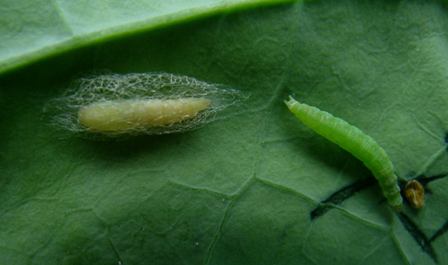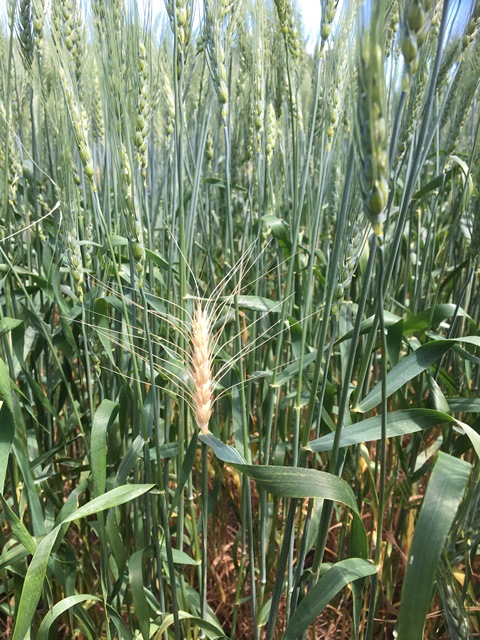Manitoba Insect & Disease Update
Issue 8: July 18, 2018
Summary
Insects: Diamondback moth were near threshold levels in some canola fields in Eastern Manitoba and the Southern Interlake. Management decisions for diamondback moth need to be made based levels of larvae shaken from canola plants, not levels caught in a sweep net. Larvae can complete their development quickly in hot temperatures, so larval populations can change in a field quickly.
No soybean aphids have been reported yet.
Diamondback Moth
Sweep Net Counts and Diamondback Moth: Some have asked whether levels of diamondback moth caught in a sweep net can be used to make management decisions. There has never been a correlation established between diamondback moth caught in a net, and levels per ft2 or m2 of plants. And it may be highly variable, depending on plant stage, where larvae are predominantly feeding on the crop, etc.
Last year an agronomist reported getting about 100 diamondback moth per 10 sweeps, and only about 6 per ft2 in the same area, which is well below the economic threshold. And this past week an agronomist reported getting about 15 to 20 larvae per 10 sweeps and about 2 to 4 larvae per ft2 of plants. These are observation, not replicated studies, and can't be used to draw a correlation between sweep net numbers and numbers per ft2, from which the threshold is used. But it does show that high levels in a sweep net are not a useful means for making management decisions. What high levels in a sweep net indicate is the need to pull some canola plants, shake out the larvae, and see if you are above the threshold.
Economic threshold for diamondback moth: The nominal threshold that is used for diamondback moth in canola is that control may be required if larvae exceed 20-30 per ft2 in plants with flowers and pods. Flowering canola, however, compensates well for damage to leaves or flowers if there is good soil moisture. So except in extreme situations or drought diamondback moth management in flowering canola is rarely needed. Depending on insecticide choice, the yield boost canola gets from pollinators needs to be considered if treating flowering canola. An application at flowering if diamondback moth levels are not at or above threshold has the potential to inadvertently decrease yield if pollination is disrupted. In most instances it is best to keep monitoring levels as the canola moves into the podding stage and base management decisions on both diamondback moth levels and whether pod feeding is starting. In some years most of the larval feeding may be on the leaves, which is usually not a major concern as we move into the podding stages. In years like last year, where leaves were senescing early because of dry conditions, there may be more feeding directly to pods and potential for yield loss.
Scouting Techniques: Thresholds are based on estimating the average number of larvae that can be shaken from a foot square of plants. Instead of removing a full ft2 of plants and shaking them to count larvae, some prefer to remove individual plants, shake out and count larvae, and determine the number of plants in a square foot area on average. With some simple math it is possible to determine if the threshold is exceeded. This can work well, and may be easier in some regards. But if doing this you need to ensure plants are randomly selected, and not selected because larvae were seen on that plant. And a large enough sample size would be needed. Do this in at least 5 to 10 areas of the field is recommended.
Having something to shake plants over in the field is helpful. A beating sheet (a canvas piece of cloth on a frame) or a tray could work. In the past some have chosen to remove plants and beat them on the hood of their vehicle. This can work, but if doing this have a bucket or bag to put plants in so you are not losing larvae as you return to your vehicle.

Figure 1. Diamondback moth pupa (left) and larva (right).
Insect Monitoring Programs
Bertha Armyworm: Out of ninety-nine traps, 88 currently have cumulative counts in the low risk category (less than 300), one trap is in the moderate risk range, and 10 traps are in the uncertain risk category. Most of the highest cumulative counts so far are in the western part of Manitoba. Traps counts in eastern Manitoba and the Interlake have generally been quite low.
Table 1. Highest cumulative trap counts for bertha armyworm adults over the trapping period June 3 to July 17, 2018.
0-300=low risk 300-900=uncertain risk 900-1,200=moderate risk 1,200+=high risk
| Location | Region | Count | Risk |
|---|---|---|---|
| Tilston | Southwest | 960 | Moderate |
| Somerset | Central | 470 | Uncertain |
| Pierson | Southwest | 468 | Uncertain |
| Bowsman | Northwest | 404 | Uncertain |
| Inglis | Northwest | 381 | Uncertain |
| Kenville | Northwest | 342 | Uncertain |
| Benito | Northwest | 335 | Uncertain |
| Inglis | Northwest | 328 | Uncertain |
| Mather | Central | 321 | Uncertain |
| Benito | Northwest | 307 | Uncertain |
| Russell | Northwest | 306 | Uncertain |
This trapping provides information on the regional risk of bertha armyworm potentially getting to higher levels of larvae. The trap counts have little relevance for the field the trap is in, but assessing the traps captures from the various traps in a region can indicate the risk and importance of sampling levels of larvae in a region. At no point should a management decision be made based on trap counts. Such decisions need to be made based on levels of larvae.
While scouting canola, assessing levels of bertha armyworm larvae is encouraged, particularly in the western part of Manitoba where a few traps have reached the uncertain and moderate risk range.
Insect Identification Quiz
You are seeing white heads like this in wheat. The head seems to pull out easily, and it is just the upper part of the plant that is affected. What caused this? Hint - it is not wheat stem sawfly, which at our Crop Diagnostic School many thought it was when quizzed on this.

Answer: This is caused by the larvae of wheat stem maggot, Meromyza americana. This is one of those insects where the damage is very visible. Except in more extreme circumstances yield loss is usually minor, although the appearance of even one white head per couple of hundred plants can look really bad. There are no insecticides for control of wheat stem maggot. Crop rotation can limit damage in small grain cereals. One more reason to make sure you have good rotations. Six species of Hymenopteran parasites of wheat stem maggot were found in cereal crops in a study in South Dakota.
----------------------------------------------------------------------------------------------------------------------
Compiled by:
John Gavloski, Entomologist Holly Derksen, Field Crop Pathologist
Manitoba Agriculture Manitoba Agriculture
Phone: (204) 750-0594 Phone: (204) 750-4248
To report observations on insects or plant pathogens that may be of interest or importance to farmers and agronomists in Manitoba, please send messages to the above contacts.
To be placed on an E-mail list so you will be notified immediately when new Manitoba Insect and Disease Updates are posted, please contact John Gavloski at the address or numbers listed above.

